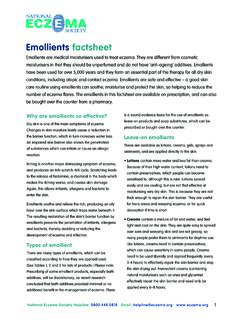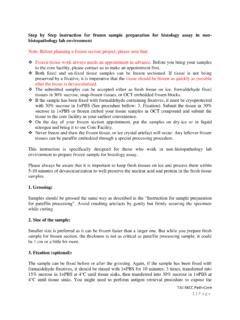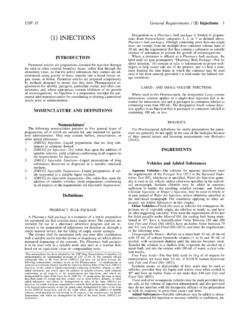Transcription of HOW TO DETERMINE AIR FLOW - TSI.com
1 HOW TO DETERMINE air flow by Airflow Developments Limited Laboratory test methods. BS848: Part 1 is the Standard that fan manufacturers' use to DETERMINE the air performance of all types of fans with the exception of those fans designed solely for air circulation. ceiling fans and table fans. The 1963 version offered 9 test methods, and consisted of 77 pages of A5 size. The 1980 version introduced standardised airways, recognised 4 installation types with at least 4 test methods for each installation. The publication had increased by just 2 pages in length, but was now doubled to A4 size. The 1997 version is better known as ISO5801. It represents basic agreement internationally for air performance test methods, and is the result of almost thirty years of discussion, comparative testing and detailed analyses by leading specialists from research organisations and the fan industry throughout the world.
2 The publication now extends to 232 A4 pages. Clearly AIR is not conducive to being measured. We cannot see it. Its motion is three dimensional and turbulent, and it would need a great many measurements of velocity and direction to integrate a total volume flow, unless the air were first collected and then straightened in a suitable test airway. What we do have are test procedures for determining a fan's performance that will produce repeatable results under laboratory conditions. [When ducting is attached to the inlet, outlet, or both inlet and outlet, of a fan, its performance is changed] Fans are classified according to the four types of installation: Type A - Free inlet, Free outlet, Type B - Free inlet, Ducted outlet, Type C - Ducted inlet, Free outlet, Type D - Ducted inlet, Ducted outlet. It is also recognised that to achieve a repeatable and consistent determination of fan pressure, it is necessary to fit standardised duct sections to the inlet or outlet of the fan.
3 To illustrate the four classification types and show the standardised inlet and outlet ducts, Figure 1 shows the determination of flow rate by use of inlet or outlet orifice. Page 2 Type A - Free inlet and outlet. Type B - Free inlet, Ducted outlet. Type C - Ducted Inlet, Free outlet. Type D - Ducted Inlet and Outlet ( Note: the fan under test is signified as [V] Page 3 Figure 1/. Illustration of the four classification types of installation. Site testing. It has been stated that fan manufacturers are able to give a fan s performance tested under laboratory conditions. In practice, however, a fan is rarely installed in a system identical to such conditions. Normally there are obstructions within the system that cause resistance to flow. Most component manufacturers produce resistance to flow data and system designers are able to estimate an overall resistance to flow and size a fan accordingly.)
4 However, there will always be instances where the system does not operate to the design specification and it is not uncommon to suggest that the fan is not doing what it ought. Some designers will over specify the fan in order to overcome such deficiencies. This, whilst solving any foreseeable problems, is very energy inefficient, and does not correct the problem at source. Discrepancies may be due to any of the following: Leakage, recirculation, or other faults within the system; Inaccurate estimation of flow resistance; Erroneous application of the standardised fan data; Excessive loss in a system component located too close to the fan inlet, outlet, or elsewhere; Disturbance of the fan performance caused by a bend or other system component located too close to the fan inlet. It should be appreciated that the accuracy achieved on site will be substantially inferior than that achieved under laboratory conditions, and where a site test forms the basis of a fan acceptance test, the manufacturer should have the opportunity to inspect the system design in order to: (1).
5 Agree the best locations for measurement, (2). Have the opportunity to advise any changes to the system that will affect the overall performance of the fan. The volume flow rate in a system can be measured at the entrance to the system, at the exit from the system, or somewhere within the system. This could involve measuring the total volume flow rate or the flow rate in a portion of the system. It is always possible to install a permanent measuring device within the system. This could be integrated as part of a management system and can be relatively inexpensive when compared to the total cost of the system. Page 4 Wherever it is measured, it should be a prerequisite that the flow should be swirl-free; checks should also be made to ensure that the fan and any associated components are functioning properly; and that the fan operating speed is stable. The system is operating at steady conditions (temperature).
6 BS848: Part 1: 1980 gives instructions for site testing and location of measurement planes. The flow measurement plane should preferable be sited at the inlet to the fan. Bends, contractions and other obstructions should be situated as far away from the measuring plane as is practicable. It is allowed to introduce guide vanes in order to improve the flow conditions. For the purposes of measuring the pressure rise across the fan, the static pressure should be measured close to the fan inlet and outlet. Where it is not possible to measure close to the fan, allowances have to be made for duct friction effects between the fan and the measuring plane. What has to be appreciated is that where irregular flow conditions are present, there will be a component of velocity pressure present and may be recorded as well as the static pressure and this will lead to erroneous readings. The measuring planes for recording flow and pressure as laid out in BS848: Part 1: 1980 are shown below.
7 Figure 2 - Location of pressure measuring plane for site testing. Page 5 Figure 3 - Location of the flow measuring planes for site testing. There is at present, waiting in the wings, a draft ISO/DIS 5802 standard entitled 'Industrial fans - Methods of performance testing in situ' and will be compulsive reading for those testing on site. Page 6 How to measure pressure. It is not proposed to venture to fully into the fundamental principles as this has been covered in previous seminars, except to say that the only pressure acting a point in a stationary fluid is hydrostatic pressure which acts equally in all directions. When the fluid is set in motion, there is an additional dynamic pressure due entirely to the motion of the flow and the density of the fluid. The algebraic sum of the static pressure and the velocity pressure is called the total pressure. Pressure measurements are usually made relative to atmospheric pressure and are corrected to Standard Conditions such that comparisons between readings are possible.
8 The internationally agreed Standard Conditions for air having a density of kg/m . Practical methods of measuring volume flow rate. Measuring Total and Static Pressure. A tube placed in a duct facing into the direction of the flow will measure the total pressure in the duct. If frictional losses are neglected, the mean total pressure at any cross section throughout the duct system is constant. Static pressure can only be determined accurately by measuring it in a manner such that the velocity pressure has no influence on the measurement at all. This is carried out by measuring it through a small hole at the wall of the duct; or a series of holes positioned at right angles to the flow in a surface lying parallel to the lines of flow. The pitot static tube is an example of this. Figure 4 shows the principle of the pitot static tube. It will be seen that connecting tubes to a manometer makes the measurement of pressure.
9 Page 7 Figure 4. Principle of the pitot static tube. Page 8 Instruments for measuring pressure. [1]. U TUBE MANOMETER. Although probably the oldest method of measuring low pressures, the simple U tube has much to commend it. If a U shaped glass tube is half filled with a liquid , water, and a pressure is applied to one end of the limb, the other being open to atmosphere, the liquid will move to balance the pressure. The weight of liquid so displaced will be proportional to the pressure applied. As the difference in height of the two columns of liquid and the density are known the pressure can be calculated. Each millimetre height difference of water column represents approximately 10 Pascals. Figure 5. Principle of the U-tube manometer. A disadvantage of the U tube is that the scale has to be constantly moved to line up with the moving zero Page 9 Alternatively with zero taken at the centre point the scale length is halved with subsequent loss of resolution.
10 [2]. liquid - IN GLASS MANOMETERS. The disadvantages of the simple U tube manometer are overcome and other advantages incorporated in single limb industrial manometers in which it is only necessary to read one liquid level. In one such design, one of the limbs of the U tube is replaced by a reservoir, thus substantially increasing the surface area. A pressure applied to this reservoir causes the level of fluid to move a small, calculable amount. The same volume of fluid displaced in the glass limb produces a considerable change in the level. This nearly doubles the resolution compared with the U tube manometer for vertical instruments and gives much greater magnification when the limb is inclined. The manometer fluid may be plain water, but problems can arise from algae growing in the tube causing the density of the fluid to alter. Special blends of paraffin are often used and these have several advantages: a free moving meniscus, no staining of the tube, and expanded scales due to low relative densities.








